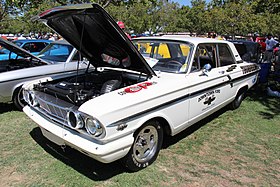
Muscle car is a description according to Merriam-Webster Dictionary that came to use in 1966 for "a group of American-made two-door sports coupes with powerful engines designed for high-performance driving." The Britannica Dictionary describes these as "an American-made two-door sports car with a powerful engine."

Funny Car is a type of drag racing vehicle and a specific racing class in organized drag racing. Funny cars are characterized by having tilt-up fiberglass or carbon fiber automotive bodies over a custom-fabricated chassis, giving them an appearance vaguely approximating manufacturers' showroom models. They also have the engine placed in front of the driver, as opposed to dragsters, which place it behind the driver.
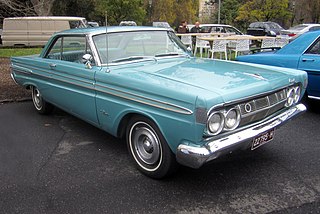
The Mercury Comet is an automobile that was produced by Mercury from 1960–1969 and 1971–1977 — variously as either a compact or an intermediate car. In its first two years, it was marketed as the "Comet" and from 1962 as the "Mercury Comet".

The Ford Galaxie is a car that was marketed by Ford in North America from the 1959 to 1974 model years. Deriving its nameplate from a marketing tie-in with the excitement surrounding the Space Race, the Galaxie was offered as a sedan within the full-size Ford range throughout its production run. In the full-size segment, the model line competed against the Chevrolet Impala and Dodge Polara.

The Ford Torino is an automobile that was produced by Ford for the North American market between 1968 and 1976. It was a competitor in the intermediate market segment and essentially a twin to the Mercury Montego line.

The Ford FE engine is a V8 engine produced by the Ford Motor Company and used in vehicles sold in the North American market between 1958 and 1976. The FE, derived from 'Ford-Edsel', was introduced to replace the short-lived Ford Y-block engine, which American cars and trucks were outgrowing. It was designed with room to be significantly expanded, and manufactured both as a top-oiler and side-oiler, and in displacements between 332 cu in (5.4 L) and 428 cu in (7.0 L).
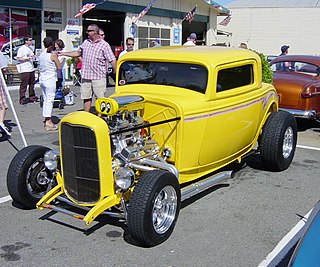
Hot rods are typically American cars that might be old, classic, or modern and that have been rebuilt or modified with large engines optimized for speed and acceleration. One definition is: "a car that's been stripped down, souped up and made to go much faster." However, there is no definition of the term that is universally accepted and the term is attached to a wide range of vehicles. Most often they are individually designed and constructed using components from many makes of old or new cars, and are most prevalent in the United States and Canada. Many are intended for exhibition rather than for racing or everyday driving.

Car tuning is the modification of a car to optimise it for a different set of performance requirements from those it was originally designed to meet. Most commonly this is higher engine performance and dynamic handling characteristics but cars may also be altered to provide better fuel economy, or smoother response. The goal when tuning is the improvement of a vehicle's overall performance in response to the user's needs. Often, tuning is done at the expense of emissions performance, component reliability and occupant comfort.

The Shelby Mustang is a high-performance variant of the Ford Mustang built by Shelby American from 1965 to 1967 and by the Ford Motor Company from 1968 to 1970.

Pro stock is a class of drag racing featuring "factory hot rods". The class is often described as "all motor", due to the cars not using any form of forced induction such as turbocharging or supercharging, or other enhancements, like nitrous oxide, along with regulations governing the modifications allowed to the engines and the types of bodies used.

The Ford Fairlane is an automobile model that was sold between the 1955 and 1970 model years by Ford in North America. Taking its name from the Dearborn, Michigan estate of Henry Ford, the Fairlane nameplate was used for seven different generations of vehicles. Through its production, the model line would be marketed in a wide variety of body styles, including two-door and four-door sedans, two-door and four-door hardtops, station wagons, and both traditional and retractable-hardtop convertibles.
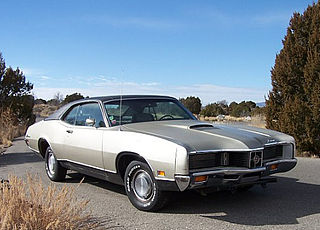
The Mercury Cyclone is an automobile that was marketed by the Mercury division of Ford from 1964 to 1971. Introduced in 1964 as the Mercury Comet Cyclone, the Cyclone replaced the S-22 as the performance-oriented version of the Mercury Comet model line. The Cyclone became a distinct nameplate for the 1968 model year, as the Mercury Montego was phased in to replace the Comet.
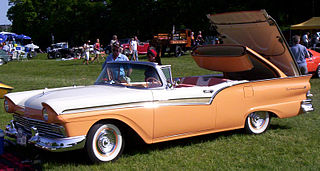
The mainstream Ford line of cars grew substantially larger for 1957, a model which lasted through 1959. The Crown Victoria with its flashy chrome "basket handle" was no more, and the acrylic glass-roofed Crown Victoria Skyliner was replaced by a new model, the retracting-roof hardtop Skyliner.
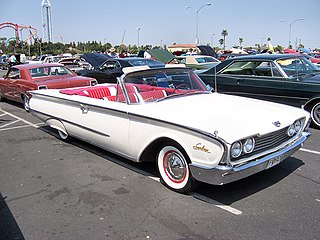
Leading into the 1950s, Ford, along with many other top of the market car manufacturers were capitalizing on the post war boom. Many new advancements in technology and products were being developed during this time that allowed for cars going into the future to have features never seen before or features that were not normal until now. The automatic window, for example, was a new feature that made Americans see their current cars as outdated and technologically behind. The 1960s were one of the best eras for the production of cars, as the war between Ford and Chevrolet heated up and produced some of the most classic and recognizable cars in America still to this day.

Total Performance was a global promotional advertising campaign conducted by the Ford Motor Company during the 1960s. It aimed to succeed in a variety of motorsport venues, and then emphasize performance in their mainstream vehicles with the interest generated.
Billy Lewis "Wild Bill" Shrewsberry is an American exhibition drag racing driver primarily active throughout the 1960s and 1970s. Originally from Mansfield, Ohio, Shrewsberry moved to Southern California in October 1962. Shrewsberry is best known as the driver of the drag racing replica of the Barris-built Batmobile from the 1966 television series and of the "L.A. Dart," a series of wheelstanding funny cars each with a rear-mounted, supercharged Chrysler Hemi engine and each sponsored by the Dodge and Plymouth dealers of Los Angeles and Orange Counties. The result of the rearward weight transfer caused by the engine's mounting position was a "wheelie" for the entire quarter-mile at speeds exceeding 100 miles per hour (160 km/h). Steering was accomplished by a combination of the service brake pedal activating the brake on the left wheel while a brake lever from a racing go-kart activated the right brake. So proficient was Shrewsberry at this sort of driving that he would often spin his car to face the opposite direction at the end of the track and race back to the starting line, all the while maintaining the wheelstand.
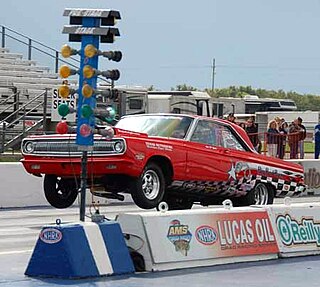
Nostalgia Super Stock is among the most popular, and fastest growing forms of drag racing. The class recreates the style of drag racing very popular in the 1960s with drivers like Ronnie Sox, Dick Landy, Butch Leal and Judy Lilly.
The Max Wedge, formally the Maximum Performance Wedge, was an engine option produced by the Chrysler Corporation from 1962 to 1964, that was available exclusively in B Platform (intermediate) Dodges and Plymouths. The Max Wedge motor used the Chrysler RB Block, and was produced in 413 and 426 cubic-inch iterations. By the strict definition of a muscle car as an intermediate-bodied vehicle equipped with a big-block engine, the 1962 Max Wedge Dodges and Plymouths were among the first so-called muscle cars.
The Hot Rod Magazine Championship Drag Races were a series of drag racing events sponsored by Hot Rod Magazine between 1964 and 1969. It was considered "one of the most significant drag racing events" of that era.
Gaspar Ronda, better known as Gas Ronda, was an American drag racer. He was also a restaurateur. In 2016, Ronda was made a member of the International Drag Racing Hall of Fame.
